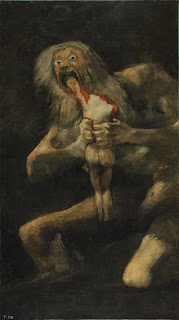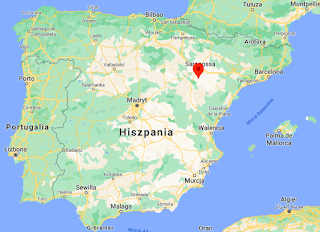Francisco Goya: Lecture Notes
I'm going to start this post with some important dates in Goya's life. Francisco Goya was born in March 1746 in Fuendetodos in Spain.
This is a screenshot of google maps showing where Fuendetodos is on the map.Years 1771-1772 are when Goya started creating his first masterpieces such as 'Adoration of the name of God' (epodreczniki.pl, n.d.)
In 1781 Goya started working on the Royal court and in 1786 he gets the title of Pintor Del Rey - King's Painter (epodreczniki.pl, n.d.). In 1780 Goya created a very famous painting 'Christ Crusified'.
Goya is generally associated with very bloody images; however, this one is oddly calm and even though he is presenting wounds on Jesus' body, there is no blood dripping off his hands or feet. That could be very confusing to people. Even I was wondering why is this painting so peaceful and I did a lot of research to find an answer. Goya used this painting along with his application to the Royal Academy of Fine Arts of San Fernando and he wanted to make sure that his academic career is successful and wasn't planning on ruining it with very bloody imagery (Francisco de Goya, 2020). This is a very interesting concept. He wanted the painting to be calm so it doesn't change the way the admissions at the school he was interested in joining would look at him. I think this is quite an interesting fact.
At the age of 47, Goya was attacked by a mysterious illness which left him deaf for the rest of his life (Cawthorne, 1962). After this illness, his paintings completely changed. They became darker and scarier. According to Cawthorne (1962) there are two options why that has happened, one being the illness could have affected Goya's brain and the other option is that Goya may wanted to rebel against his fate. I think both speculations are really interesting. They show completely different options and different ways in which an illness could affect the artist. It could have made him angry and wanting to rebel so his mentality changed or it could have really changed his brain which kind of also is a change in his mentality.
One of his most famous paintings, at least in my eyes is 'Saturn Devouring His Son'.
 |
| Saturn Devouring His Son |
This is how his paintings changed over the years. From a very clean Jesus on the cross to Saturn eating his child leaving his body covered in blood. This is the change I mentioned earlier. It could be cause by brain damage or by his own anger at everyone for what has happened to him.
In 1828 Goya died in Bordeaux in France.
This research showed me how an artist can change throughout his career. Goya is definitely one of the greatest Spanish artists and his talent is evident in those paintings. Observing how his mind worked and researching it was definitely interesting for me.
Reference list:
Cawthorne, T. (1962), 'Goya's Illness', Section of the History of Medicine, 55. Available at: https://journals.sagepub.com/doi/pdf/10.1177/003591576205500308
epodreczniki.pl (n.d.), Francisco de Goya yLucientes - malarz o "gwałtownych kontrastach, okropnościach natury, fizjologiach ludzkich dziwacznie zezwierzęconych pod wpływem okoliczności"(Charles Baudelaire). Available at: https://epodreczniki.pl/a/francisco-de-goya-y-lucientes---malarz-o-gwaltownych-kontrastach-okropnosciach-natury-fizjonomiach-ludzkich-dziwacznie-zezwierzeconych-pod-wplywem-okolicznosci-charles-baudelaire/DAfhWwNIH (Accessed: 24/04/2021).
Francisco de Goya (2020), Christ Crucified. Available at: http://www.francisco-de-goya.com/christ-crucified/ (Accessed: 24/04/2021).
Museo Goya (n.d.) THE GLORY OR ADORATION OF THE NAME OF GOD. Available at: https://museogoya.ibercaja.es/en/obras/the-glory-or-adoration-of-the-name-of-god# (Accessed: 24/04/2021).





Comments
Post a Comment